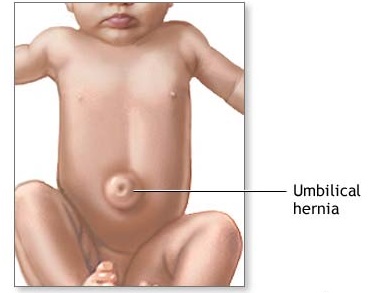Hernia is a medical condition that occurs when there is a spill out of membranes in a body cavity. This is often seen as bulges in the affected body part. Usually associated abdominal wall, hernia is common in the lower half of the body, although it can occur in other parts of the body too. Hernia represents a bulge or a lump of fatty abdomen tissues. When it occurs around the navel area, it is regarded as umbilical hernia. The intestines protrude around the umbilical region hence hernias have varied symptoms depending on their causes.
Umbilical Hernia Causes
Causes of hernia soon after birth or later in life depend on whether the abdominal midline muscles join completely or not. When a baby is in the womb, the umbilical cord passes through its abdominal muscles. This opening often locks up soon after birth. The failure of the muscle to join completely weakens the walls causing hernia.
For Children: In children, umbilical hernia or belly button hernia is often caused by the weakening of the abdominal muscle cavities. The non-closure of the opening muscles used for feeding the fetus is the major cause for infant hernia.
For Adults: Hernia can arise from hereditary factors. It can also be a result of persistent strenuous activities such as coughing, lifting heavy objects, straining among others. Consequently, hernia in adults comes about due to the accumulation of body cavity fluids, chronic lung illnesses and obesity. Generally, hernia among adults is caused by having a lot of pressure placed on the abdomen due to:
- Obesity
- Multiple pregnancies
- Ascites or fluids in the abdominal cavity
- Preceding abdominal surgery
Umbilical Hernia Symptoms and Treatments
1. Umbilical Hernia in Children
Hernia affects both boys and girls. Children with hernia will show signs soon as the umbilical cord stamp falls at birth or after some weeks. This is a bulging protruding flesh surrounding the belly button area. The hernia will often vary in size. In most cases, it is less than 2.5 cm wide. Older kids with wider hernias will feel uncomfortable among their play mates as they might be mocked.
Umbilical Hernia Symptoms
Hernia is painless but can be seen. Parents will easily notice the hernia in their children. Most hernias will have signs like:
- A soft bulging belly button or navel that appears swollen
- A painless bulge that can be pushed in
- A visible bulge when the child cries, coughs, strains the abdomen muscles or makes a bowel movement
Danger signs in the development of hernia include symptoms like vomiting, signs of an infection, redness and swelling of the hernia. If the hernia becomes discolored and shows signs of pain, medical attention is required. Infant hernia often closes up by the 1st year, or it can go up to 5 years.
Umbilical Hernia Treatments
If the hernia doesn't disappear on its own when a child is 18 months, there might be a need for a minor surgical operation to repair it. Sometimes waiting up to 5 years is appropriate. Surgery is done through a simple and quick outpatient treatment. Recovery is smooth and usually there are no complications associated with the hernia surgical procedures. However, large hernias will require extra surgery to restore the belly button and to remove the large skin. In such cases, the treatment will be done in subsequent surgeries. Before you pursue surgery consider if:
- The size of the hernia is too large.
- It is infected.
- The hernia is uncomfortable for the child.
2. Umbilical Hernia in Adults
Adults can develop hernia without having had the condition in childhood. It comes as an oversized gland in the lower abdomen area. Hernia is often painless, but it can cause discomfort during bowel movements, coughing, and urinating. This is due to the enlarged gland. It is visible in adults when there is too much abdominal pressure; for example, when an adult is involved in abdominal muscle exercises. Its symptoms are similar to those in children. Treatment is also through surgery.
Umbilical Hernia Symptoms
Hernia in adults is a painless condition, and it gradually increases in size over time. If it is not treated, it can lead to a strangulated hernia. This is more painful since the enlarged part of the intestine hinders blood circulation to the body tissue. This calls for immediate surgical treatments. There are so many myths surrounding the hernia, but medical diagnosis will ensure proper treatment.
Hernia in adults is similar to that in children except that it is much larger in size. It is noticeable in certain cases during strenuous activities, but for some people it is visibly big all the time. Those suffering from pregnancy related hernias are bound to get a post pregnancy respiratory tract infection. Although hernia is usually painless, the painful strangulated hernia will show reddish bluish color because of the poor blood circulation. It could lead to terminal illnesses like gangrene, or peritonitis. Hernia in adults could worsen if the bowel flow gets trapped inside.
Umbilical Hernia Treatments
In order to remove umbilical hernia permanently, surgery is required. Open surgery and keyhole surgery are the two main operations involved:
- The most common form is the open surgery which is used to push the contents back into the abdominal cavity. During the surgery, a synthetic wire mesh is used to strengthen the abdominal muscles.
- The keyhole surgery works well with recurrent hernias.
When to See a Doctor
Hernia should be properly diagnosed to prevent any future complications. Although it is taken lightly, it also has adverse effects that could lead to dangerous infections. In both adult and infant cases, it is advisable that you consult a doctor if you notice the following traits:
- The hernia gets painful and is tender.
- There is discoloration of the hernia.
- The patient is vomiting.
